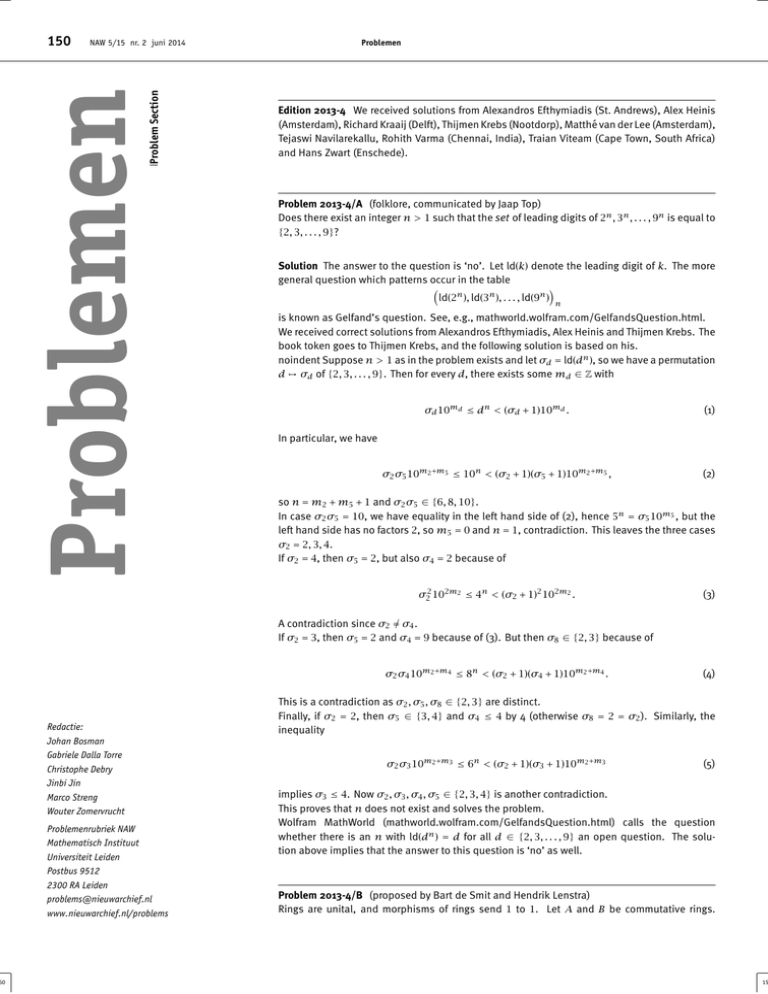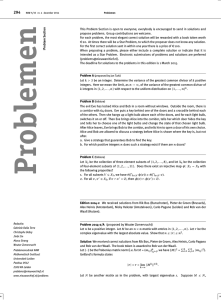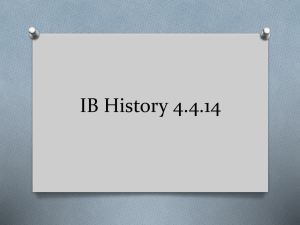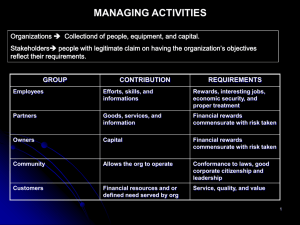Problem Section Edition 2013-4 We received solutions from
advertisement

50
Problem Section
NAW 5/15 nr. 2 juni 2014
Problemen
150
Problemen
Edition 2013-4 We received solutions from Alexandros Efthymiadis (St. Andrews), Alex Heinis
(Amsterdam), Richard Kraaij (Delft), Thijmen Krebs (Nootdorp), Matth´e van der Lee (Amsterdam),
Tejaswi Navilarekallu, Rohith Varma (Chennai, India), Traian Viteam (Cape Town, South Africa)
and Hans Zwart (Enschede).
Problem 2013-4/A (folklore, communicated by Jaap Top)
Does there exist an integer n > 1 such that the set of leading digits of 2n , 3n , . . . , 9n is equal to
{2, 3, . . . , 9}?
Solution The answer to the question is ‘no’. Let ld(k) denote the leading digit of k. The more
general question which patterns occur in the table
ld(2n ), ld(3n ), . . . , ld(9n )
n
is known as Gelfand’s question. See, e.g., mathworld.wolfram.com/GelfandsQuestion.html.
We received correct solutions from Alexandros Efthymiadis, Alex Heinis and Thijmen Krebs. The
book token goes to Thijmen Krebs, and the following solution is based on his.
noindent Suppose n > 1 as in the problem exists and let σd = ld(dn ), so we have a permutation
d 7→ σd of {2, 3, . . . , 9}. Then for every d, there exists some md ∈ Z with
σd 10md ≤ dn < (σd + 1)10md .
(1)
σ2 σ5 10m2 +m5 ≤ 10n < (σ2 + 1)(σ5 + 1)10m2 +m5 ,
(2)
In particular, we have
so n = m2 + m5 + 1 and σ2 σ5 ∈ {6, 8, 10}.
In case σ2 σ5 = 10, we have equality in the left hand side of (2), hence 5n = σ5 10m5 , but the
left hand side has no factors 2, so m5 = 0 and n = 1, contradiction. This leaves the three cases
σ2 = 2, 3, 4.
If σ2 = 4, then σ5 = 2, but also σ4 = 2 because of
σ22 102m2 ≤ 4n < (σ2 + 1)2 102m2 .
(3)
A contradiction since σ2 6= σ4 .
If σ2 = 3, then σ5 = 2 and σ4 = 9 because of (3). But then σ8 ∈ {2, 3} because of
σ2 σ4 10m2 +m4 ≤ 8n < (σ2 + 1)(σ4 + 1)10m2 +m4 .
Redactie:
Johan Bosman
Gabriele Dalla Torre
Christophe Debry
Jinbi Jin
Marco Streng
Wouter Zomervrucht
Problemenrubriek NAW
Mathematisch Instituut
Universiteit Leiden
Postbus 9512
2300 RA Leiden
problems@nieuwarchief.nl
www.nieuwarchief.nl/problems
(4)
This is a contradiction as σ2 , σ5 , σ8 ∈ {2, 3} are distinct.
Finally, if σ2 = 2, then σ5 ∈ {3, 4} and σ4 ≤ 4 by 4 (otherwise σ8 = 2 = σ2 ). Similarly, the
inequality
σ2 σ3 10m2 +m3 ≤ 6n < (σ2 + 1)(σ3 + 1)10m2 +m3
(5)
implies σ3 ≤ 4. Now σ2 , σ3 , σ4 , σ5 ∈ {2, 3, 4} is another contradiction.
This proves that n does not exist and solves the problem.
Wolfram MathWorld (mathworld.wolfram.com/GelfandsQuestion.html) calls the question
whether there is an n with ld(dn ) = d for all d ∈ {2, 3, . . . , 9} an open question. The solution above implies that the answer to this question is ‘no’ as well.
Problem 2013-4/B (proposed by Bart de Smit and Hendrik Lenstra)
Rings are unital, and morphisms of rings send 1 to 1. Let A and B be commutative rings.
15
51
Solutions
Oplossingen
Problemen
NAW 5/15 nr. 2 juni 2014
151
Suppose that there exists a ring C such that there are injective morphisms A → C and B → C of
rings. Show that there exists a commutative such ring.
Solution We received solutions from Matth´e van der Lee and Rohith Varma. The book token is
awarded to Matth´e van der Lee.
Let f : A → C and g : B → C be the given injections. The map
A × B → C,
(a, b) 7→ f (a)g(b)
is Z-bilinear, so induces a ring homomorphism h : A ⊗Z B → C . Let i : A → A ⊗Z B and
j : B → A ⊗Z B be the canonical maps. The compositions f = h ◦ i and g = h ◦ j are injective
by assumption, hence i and j are injective. The ring A ⊗Z B is commutative, so we are done.
Problem 2013-4/C (proposed by Jinbi Jin)
Let C(R, R) denote the set of continuous maps from R to itself. A (not necessarily continuous)
map f : C(R, R) → C(R, R) is called good if it satisfies, for all s, t ∈ C(R, R), the identity
f (s ◦ t) = f (s)f (t),
where the product on the right hand side is the point-wise multiplication of maps.
− Find a non-constant good map f : C(R, R) → C(R, R).
− Show that f (exp) = 0 for all non-constant good maps f : C(R, R) → C(R, R). (Here, exp is
given by x 7→ ex .)
Solution We received solutions from Alex Heinis, Richard Kraaij, Thijmen Krebs, Tejaswi Navilarekallu, Traian Viteam and Hans Zwart. The following solution (of the second part) is based
on that of Tejaswi Navilarekallu, to whom we also award the book token for this problem.
Giving a non-constant good map
Let f : C(R, R) → C(R, R) be given by
1 s is bijective,
f (s) =
0 otherwise.
Showing that f is indeed a good map amounts to proving the following lemma.
Lemma 1. Let s, t : R → R be continuous maps such that s ◦ t is bijective. Then both s and
t are bijective.
Proof. First note that t and s ◦ t are injective, so by the intermediate value theorem, they are
either strictly increasing, or strictly decreasing. Assume without loss of generality that t and
s ◦ t is strictly increasing.
Suppose for a contradiction that the image of t is bounded from above, and let M be its
supremum in R. Let x ∈ R be arbitrary, and consider the interval I = [x, ∞). As t is increasing,
it follows that the image of I under t lies in [t(x), M]. As s ◦ t is increasing and bijective, it
follows that s ◦ t(I) = [s ◦ t(x), ∞). But on the other hand, as [t(x), M] is closed and bounded,
s ◦ t(I) must be a closed and bounded interval, and this is a contradiction. Hence the image
of t is not bounded from above, and similarly, we can show that it is not bounded from below
either. As t is a strictly increasing continuous map, it follows that t is a bijection, and hence
that s is a bijection as well, as desired.
Showing that f (exp) = 0 for f non-constant and good
Let f be a non-constant good map. In what follows below we denote by 0, 1 and −1 the constant
maps taking the corresponding values.
Let
x if x > 0,
i(x) = x, j(x) = −x, u(x) =
0 otherwise.
15
52
NAW 5/15 nr. 2 juni 2014
Solutions
Oplossingen
152
Problemen
For any s ∈ C(R, R) such that s ◦ s = s we have f (s) = f (s ◦ s) = f (s)f (s). Since f (s) is a
continuous function, it follows that f (s) = 1 or f (s) = 0.
Note that i ◦ i = i, so f (i) = 1 or f (i) = 0. If f (i) = 0, then f (s) = f (s)f (i) = 0 for all s ∈ C(R, R)
and thus f is constant, contrary to our assumption. Therefore f (i) = 1. Also note that 0 ◦ 0 = 0,
so f (0) = 1 or f (0) = 0. If f (0) = 1, then f (s) = f (0 ◦ s) = 1 for all s ∈ C(R, R), so f is again
constant, contrary to our assumption. Hence f (0) = 0. Finally, note that f (i) = f (j ◦ j) = f (j)2
and hence f (j) = 1 or f (j) = −1.
Now
f (u)f (j) = f (u ◦ j)
= f (u ◦ u ◦ j) = f (u)f (u ◦ j) = f (u ◦ j)f (u) = f (u ◦ j ◦ u)
= f (0) = 0.
Since f (j) = ±1, it follows that f (u) = 0. Therefore, as u ◦ exp = exp, we have f (exp) =
f (u ◦ exp) = f (u)f (exp) = 0.
15
22
Problem Section
NAW 5/15 nr. 3 september 2014
Problemen
222
Problemen
Erratum to solution 2013-4/B. The map h : A ⊗Z B → C is not necessarily a ring homomorphism; it is just a Z-module homomorphism. Nevertheless, the natural maps i : A → A ⊗Z B
and j : B → A ⊗Z B are ring homomorphism, so the proof is unaffected.
Redactie:
Johan Bosman
Gabriele Dalla Torre
Christophe Debry
Jinbi Jin
Marco Streng
Wouter Zomervrucht
Problemenrubriek NAW
Mathematisch Instituut
Universiteit Leiden
Postbus 9512
2300 RA Leiden
problems@nieuwarchief.nl
www.nieuwarchief.nl/problems
22












